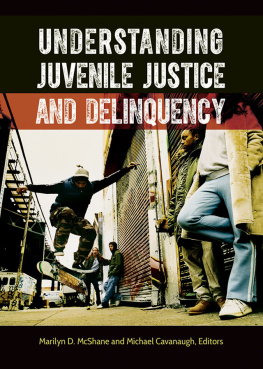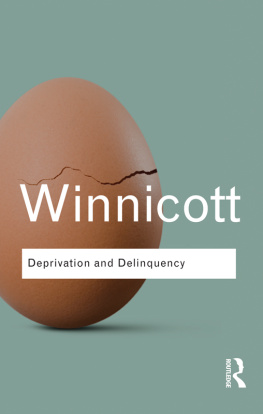DELINQUENCY AND DRIFT
DELINQUENCY AND DRIFT
David Matza
With a New Introduction by the Author
Originally published in 1964 by Joun Wiley & Sons.
Published 1990 by Transaction Publishers
Published 2017 by Routledge
2 Park Square, Milton park, Abingdon, Oxon OX14 4RN
711 Third Avenue, New York, NY 10017, USA
Routledge is an imprint of the Taylor & Francis Group, an informa business
New material this edition copyright 1990 by Taylor & Francis.
All rights reserved. No part of this book may be reprinted or reproduced or utilised in any form or by any electronic, mechanical, or other means, now known or hereafter invented, including photocopying and recording, or in any information storage or retrieval system, without permission in writing from the publishers.
Notice:
Product or corporate names may be trademarks or registered trademarks, and are used only for identification and explanation without intent to infringe.
Library of Congress Catalog Number: 89-36383
Libraty of congress Cataloging-in-Publication Data
Matza, David
Delinquency and drift/by David Matza.
p. cm.
Reprint. Originally published: New York: Wiley, 1964.
ISBN 0-88738-804-3
1. Juvenile delinquency. 2. Criminal psychology. 3. Deviant behavior.
4. Juvenile delinquencyUnited States. I. Title.
HV9069.M37 1989 89-36383
364.3'6'0973dc20 CIP
ISBN 13: 978-0-88738-804-0 (pbk)
To Cynthia, Naomi, and Karen
Contents
I N this book I have attempted to develop a conception of delinquency which differs in some ways from that projected in positive criminology. In revising the current conception, I have tried to fit many of the empirical observations of positive criminologists into a framework more consistent with classical assumptions and teachings. The main teaching of classical criminology was the insistence that the criminal be seen in a legal context. Consequently, I have stressed throughout the connection between delinquent thought and the ideas and practices that pervade contemporary juvenile law and its administration. This connection is expressed in the idea of neutralization, by which the legal bind is episodically subverted on its own terms, and a conception of subterranean support, by which agents of convention and law unwittingly and with good will contribute their services and sentiments to the feasibility of neutralization.
In developing a conception of the classic delinquenta delinquent seen in legal contextI have been led quite naturally, or so I would like to believe, to a portrayal that incorporates the associated assumptions of classical criminology. Thus, I have tried to convey the sense in which the precepts featured in a subculture of delinquency are only marginally different from those apparent in common sentiments of American life; and I have attempted to utilize the classic conception of a will to crime in order to maintain the ineradicable element of choice and freedom inherent in the condition of delinquent drift.
D AVID M ATZA
T HE number of debts one incurs in writing a book is surprisingly large. There are the family members who bear the heavy burden of oscillation between irritable depression and mindless immersion, the many colleagues and students who give freely of their time in criticizing the ideas that go into a manuscript, and the institutions which in a variety of ways expedite the observing, thinking, and writing that go into a book. It is a mark of the generosity of familial, collegial, academic, and granting institutions that in each case the author never really repays the debts he has incurredhe merely acknowledges them.
Many persons have commented on various portions of the manuscript at different stages of its development. Their comments have been intellectually helpful and emotionally supportive. Whenever possible I have responded to suggestions made by Melvin Tumin, Albert Cohen, James Short, Donald Cressey, William Petersen, Sheldon Messinger, Erving Goffman, Ruth Korn-hauser, Philip Selznick, Aaron Cicourel, Edwin Lemert, Irving Piliavin, Jerome Skolnick, Carl Werthman, Sally Davis, and Marvin Scott. If some of those mentioned do not recognize what appears in this book, it is because I took their criticisms of an earlier manuscript so seriously as to write what I think is a fundamentally different book.
I wish also to thank the institutions that in many ways afforded me the time and supplied the facilities with which this book could be written. These institutions include the Law School at the University of Chicago and its Program for Behavioral Science and Law which was supported by the Ford Foundation and stimulated by Dean Levi, Francis Allen, Hans Zeisel, and others; the Center for the Study of Law and Society at the University of California, directed and guided by Philip Selznick and Sheldon Messinger, and the President's Committee on Youth Crime and Juvenile Delinquency whose financial support and initial encouragement led to the formation of a Curriculum Development Program in Crime and Delinquency. That program is one of the projects of the Center for the Study of Law and Society, and this book is one of a series of contributions that will emanate from it.
Finally, I should like to acknowledge my special debt to Gresham Sykes. Many of the ideas in this book were first developed in collaboration with him. If in this independent effort any additional contribution is made, he must receive a large share of the credit. If, however, my efforts have been misguided, I alone am responsible.
D.M.
D ELINQUENCYand Drift is about juvenile delinquency from about 1956 (when I began doing research in a New Jersey reformatory interviewing delinquents) to 1964, when the book was published. However, it is steeped in earlier experiencesattending and working in settlement houses of East Bronx and East Manhattan from (1945 to 1953); the events of the Depression in mideast Harlem (1790 Madison Avenue) from 1930 to the June 21 beginning (one of many beginnings) of World War II; and wartime experiences in the East Bronx (at 1102 Simpson Street).
My image of delinquency is somewhat older than James Gilbert's, whose interesting book A Cycle of Outrage suggests the Kefauver hearings as a main source of public consciousness regarding juvenile delinquency. I recall the Kefauver hearings and reading about them while doing doctoral dissertation, research which was based on interviews of Jamesburgh, New Jersey, State Home for Boys. A few years later, I augmented my research with observations of the juvenile court in Chicago, 1960. A few more years for writing takes us to 1964 when Delinquency and Drift was published.
The years between 1956 and 1964 were spent teaching and reading the literature in criminology, delinquency, and social problems with an eye toward writing a general text or two, the second being Becoming Deviant in 1969. Now, a few decades later, I write a new introduction to Delinquency and Drift. Given the benefit of aging, and thus perspective, my best effort at introduction is to try to put the matter of juvenile delinquency in some sort of historical perspective.
The Juvenile Delinquent in History
During the many years since Americas victories in the two world wars, the shape of world, national, and social institutions changed. Within this period, the juvenile delinquent emerged as a figure of history, not a major figure, but a minor character, whose stature now as the 1990s approach, rises to journalistic and even political prominence.









